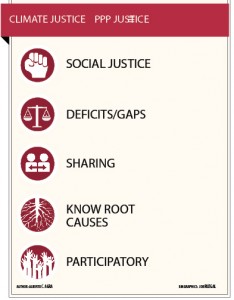‘Responsive-ility’ and responsibility Public-Private Partnership (PPP) arrangements—whether for water, reclamation, power, mass transport systems and…
Human-centered: Seeing PPP justice like climate justice
Human-centered: Seeing PPP justice like climate justice
 How can “climate justice” be likened to “public-private partnership [PPP] justice?” Why is justice even relevant when we talk about climate and PPPs? How can social justice be integrated into PPP and climate justice? What makes PPP just and unjust?
How can “climate justice” be likened to “public-private partnership [PPP] justice?” Why is justice even relevant when we talk about climate and PPPs? How can social justice be integrated into PPP and climate justice? What makes PPP just and unjust?
According to the Mary Robinson Foundation, “climate justice links human rights and development to achieve a human-centered approach, safeguarding the rights of the most vulnerable people and sharing the burdens and benefits of climate change and its impacts equitably and fairly.”
Per the Alternatives for Community and Environment, “climate justice focuses on the root causes of climate change. As a movement, climate-justice advocates are working from the grassroots up to create solutions to our climate and energy problems that ensure the right of all people to live, learn, work, play and pray in safe, healthy and clean environments.”
PPPs should be, thus, reframed and advanced like climate justice. There are five ways.
- Beyond the legal, financials and technical. Climate justice goes beyond and much deeper than the environment. Similarly, PPP justice is much more than just being compliant with law, economically feasible and technically sound. PPPs must be pursued to serve the true north. The benefits of PPP must not be exclusive to the parties to a PPP. The benefits of PPPs must be actually felt by the people. This is inclusive development.
- People as core. PPPs must be undertaken to benefit the people, improve their quality of life and enhance the public good. Like climate justice, development should be achieved through a human-centered approach. PPPs, therefore, cannot be antipeople, antichange, antidevelopment, anti-innovation and antiparticipation.
- Addresses deficits. A PPP project should not be undertaken for its own sake. A PPP is a development and change strategy aimed at addressing the root causes of poverty, democratic deficits and infrastructure gaps. PPP serves as a bridge to bring us from what is to what should be. Road, water, power, tourism, land development, reclamation, bridge, school, transportation and housing projects under various PPP schemes are necessities and imperatives.
- Social justice. Without development, the marginalized will remain in the periphery. Without participation, the underprivileged will remain fence sitters. PPP justice must be designed to attain social justice. Further, in the very process that this goal is met, the silent majority should be part of the kitchen and become active participants in the PPP cycle. PPP must not only be ethical in content. It must, likewise, be ethical in process.
- “Sharing in the burdens and benefits.” PPP is about resource exchange. The PPP parties—the government, the private-sector proponent and the beneficiaries/consumers —all have a stake, must share in the burden and benefits of the project. PPP is a win-win-win, not just a win-win between the signatories to a PPP contract. To future-proof the arrangement, the reason for PPPs—the people must be coparticipants, coowners, cofunders, codesigners, codevelopers, cocommunicators
and cothinkers.
Let us all be part of PPP and climate justice.
